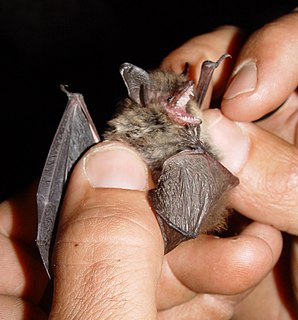
The whiskered bat is a small European bat with long fur. Although uncommon, M. mystacinus is often found around human habitation and around water; it is similar to Brandt's bat, from which it was distinguished as a separate species only in 1970.

The mouse-eared bats or myotises are a diverse and widespread genus (Myotis) of bats within the family Vespertilionidae. The noun "myotis" itself is a New Latin construction, from the Greek "muós and "oûs", literally translating to "mouse-eared".

The red myotis is a vesper bat species found in Argentina, Brazil, Paraguay and Uruguay.

The fraternal myotis is a species of vesper bat. An adult fraternal myotis has a body length of about 5 cm, a tail of about 4.5 cm, and a wing span of about 3.8 cm.

The large-footed bat, large-footed mouse-eared bat, or large-footed myotis is a species of vesper bat. It can be found in the following countries: Australia, Indonesia, Malaysia, Papua New Guinea, Singapore, Solomon Islands, Taiwan, Vanuatu, and possibly Vietnam.

The Szechwan myotis is a species of vesper bat. It is found in China and Thailand.
Peters's myotis or the small black myotis is a species of insectivorous vesper bat. It is found in Indonesia, Malaysia, Thailand, Vietnam, and the Philippines; its exact distribution is uncertain as it is difficult to distinguish from some other Myotis species. It appears adaptable to a variety of habitats, including primary tropical moist lowland forest, secondary forest, agricultural areas and villages.

Myotis fimbriatus is a species of vesper bat in the family Vespertilionidae. It is found only in China. It's also called the fringed long-footed myotis. The fringed long-footed myotis is described as having short, thick, brown fur with pale whitish fur ventrally. A captured female was measured with ears that were 14.4 mm long, a forearm 42.2 mm long, and a weight of 9.9 grams. Myotis fimbriatus is listed as being of least concern by the IUCN as of 2008. In 2000, Myotis fimbriatus was listed as being "lower risk/near threatened".
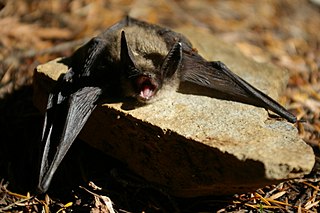
Keen's myotis is a species of vesper bat. It is found in British Columbia in Canada and in Washington and Alaska in the United States. It is named after the Rev. John Henry Keen, who collected the specimen that formed the basis for the first scientific description of the species. Classification for Keen's myotis formerly included the Northern long-eared Myotis, resulting in older studies confusing the species for one another.
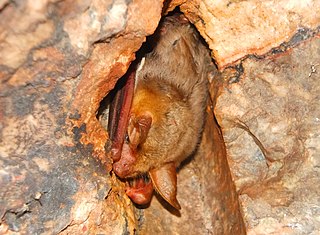
The Felten's myotis is a species of vesper bat.
Schaub's myotis is a species of vesper bat. It is found in Armenia, Azerbaijan and Iran and known from fossils from Hungary. It is related to Myotis nattereri.

The rufescent darkeye, also known as the bicoloured white-eye, is a species of bird in the family Zosteropidae. It is monotypic within the genus Tephrozosterops. It is endemic to the island of Seram in Indonesia. Its natural habitats are subtropical or tropical moist lowland forest and subtropical or tropical moist montane forest.

Myotinae is a subfamily of vesper bats. It contains three genera: Eudiscopus, Myotis, and Submyotodon. Before the description of Submyotodon and analysis of its phylogenetics, as well as a phylogenetic analysis of Eudiscopus, the only member of Myotinae was Myotis.

The Seram mountain pigeon is a species of bird in the pigeon family Columbidae that is endemic to the island of Seram in Indonesia, where it inhabits hill forest. It was long considered to be a subspecies of the Buru mountain pigeon, but was split on the basis of differences in appearance. It is a medium-sized pigeon with a buff-pink face and breast, wine-pink underparts, a grey nape, crown, back of neck, and thighs, and dark chestnut belly and underside of the tail.

The Bocharic myotis or Bokhara whiskered bat is a species of mouse-eared bat in the family Vespertilionidae, described in 1950, and indigenous to Tajikistan, and Uzbekistan.

Myotis nipalensis commonly known as Nepal myotis is a vesper bat of genus Myotis.

The southern myotis, also known as large-footed myotis, is a species of vesper bat (Vespertilionidae) in genus Myotis. The southern myotis is one of only two Australian "fishing" bats and feeds by trawling its specially adapted feet along the water's surface for aquatic invertebrates and fish.
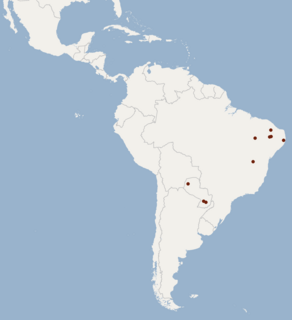
LaVal's myotis is a species of bat found in Brazil and Paraguay.
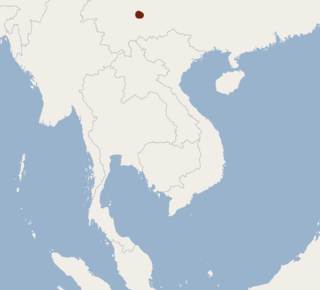
The chestnut myotis is a species of mouse-eared bat in the family Vespertilionidae. It is found in South Asia.
Myotis annatessae is a recently described species of bat in the family Vespertilionidae. It is endemic to Vietnam and Laos.

















